

|
|
|
|
|
R′ |
|
SnR′′3 |
|
R |
|
Pd |
|
X + |
' |
|
|
' |
|
|
|
|
|||||
|
|
|
|
|
|
|
|
|
III.2.3 Overview of the Stille
Protocol with Sn
MASANORI KOSUGI and KEIGO FUGAMI
A. INTRODUCTION
The Stille protocol is defined as the carbon–carbon bond formation by Pd-catalyzed coupling of organic electrophiles (usually halides or triflates) with organotin reagents (Scheme 1). Organotin reagents tolerate a variety of functional groups that many other reactive organometallics do not. Moreover, since most organotin reagents are sensitive to neither moisture nor oxygen, they can easily be isolated and stored. Many functionalities on the electrophiles can also survive the cross-coupling reaction. Thus, organic chemists can easily handle them but with special care because of their toxicity. In consequence, a number of preparation techniques for such reagents have been developed and this protocol has widely been applied to syntheses of a vast number of densely functionalized substances such as biologically intriguing compounds.
The present overview starts with early historical developments. The Pd-catalyzed reaction of organotin compounds was first published by Eaborn’s group in 1976 (Scheme 2).[1] It was initially considered as a variation of the Kharasch-type reaction, namely, radical reaction.
In 1977, three reports appeared from Kosugi and Migita’s group, which are concerned with transition metal-catalyzed carbon–carbon bond-forming reactions, that is, rhodiumcatalyzed reaction of acid chlorides with allyl or benzyltributyltin,[2] Pd-catalyzed reaction of acid chlorides with other organotins,[3] and then Pd-catalyzed reaction of aryl halides with allyltributyltin.[4] The Milstein–Stille paper that appeared in 1978 was on a ketone synthesis utilizing acid chlorides and organotin compounds catalyzed by BnPdCl(PPh3)2 in HMPA.[5],[6] The reaction conditions became milder and the yields higher. Subsequently, the solvent was changed to chloroform to avoid the strongly carcinogenic HMPA (Scheme 3).[7]
In 1979 the reaction of benzyl and aryl halides as well as its mechanism were reported.[8],[9] The first Pd-catalyzed carbonylative coupling of organic halides with organotin compounds was reported by Tanaka in the same year (Scheme 4).[10]
Aldehyde synthesis by means of the Pd-catalyzed reduction of acid chloride using tributyltin hydride was published by Four and Guibe in 1980.[11],[12] The first report from Beletskaya’s group also appeared in 1980.[13] She has developed a wide variety of
Handbook of Organopalladium Chemistry for Organic Synthesis, Edited by Ei-ichi Negishi ISBN 0-471-31506-0 © 2002 John Wiley & Sons, Inc.
263

264 |
III Pd-CATALYZED CROSS-COUPLING |
3 |
[Pd] |
− |
3 |
RX + R′SnR′′ |
|
R R′ + |
R′′SnX |
Scheme 1
Pd(PPh3)4
ArBr + Bu3SnSnBu3  ArSnBu3 + ArAr + Bu3SnBr
ArSnBu3 + ArAr + Bu3SnBr
in PhMe
Scheme 2
BnPdCl(PPh3)2
RCOCl + Bu3SnR′  RCOR′ + Bu3SnCl
RCOR′ + Bu3SnCl
in CHCl3
Scheme 3
PhPdI(PPh3)2
R1X + CO + R24Sn  R1COR2
R1COR2
30 atm CO,
in HMPA
Scheme 4
reactions using mainly ligandless palladium catalysts and published her review in 1983.[14] The scope of the reaction was widened by employment of vinyl triflates instead of halides as organic electrophiles that was introduced by Stille and co-workers in 1984.[15]
Stille’s famous review was published in 1986.[16] Mitchell’s review is also noteworthy.[17] Since then it has been recognized that the organotin protocol is useful for organic synthesis. The monograph Tin in Organic Synthesis was published in 1987.[18] Mitchell’s next review covered the literature from 1985 to 1990.[19] A number of synthetic applications were introduced in it. In the 1990s striking advances were brought about by Farina, who developed new ligands on palladium such as tri(2-furyl)phosphine and triphenylarsine and introduced copper(I) salts as additives to make the reaction conditions milder and the yields higher.[20]–[23] Recent progress up to 1996 was surveyed by Mitchell in the monograph Metal-Catalyzed Cross-Coupling Reactions in 1998.[24]
A comprehensive survey of this protocol was given by Farina, Krishnamurthy, and Scott in 1997.[25]
The present overview is not concerned with the comprehensive story, but with typical types of reactions in this protocol.
B. GUIDING MECHANISM
The first discussed mechanism was for the reaction with benzylic and aryl halides in 1979.[8],[9] As shown in other protocols, the three-step catalytic cycle is widely accepted, that is, oxidative addition, transmetallation, and reductive elimination (Scheme 5).
The reaction is supposed to start with oxidative addition of an electrophilic component to Pd(0) species. Pd(0) catalysts such as Pd(PPh3)4 and Pd(dba)2 with or without an added ligand are often used. Although Pd(II) catalyst precursors such as PdCl2(PPh3)2,

III.2.3 OVERVIEW OF THE STILLE PROTOCOL WITH Sn |
265 |
|||||||
|
|
PdX2 |
|
|
|
|
|
|
|
2 Bu3Sn-X |
|
2 R-SnBu3 |
|
||||
|
|
|
||||||
|
|
|
|
|
|
|
||
|
|
R-Pd-R |
|
|||||
|
|
R-R |
|
|
|
|
|
|
|
|
Pd(0) |
|
|
R′-X |
|
||
R′-R |
|
|
|
|
|
|||
Reductive |
|
|
|
|
|
Oxidative |
|
|
|
|
|
addition |
|
|
|||
elimination |
|
|
|
|
|
|
|
|
|
|
|
|
|
|
|||
|
R′-Pd-R |
|
|
|
|
|
||
|
R′-Pd-X |
|
||||||
|
|
|||||||
|
Bu3Sn-X |
R-SnBu3 |
|
|||||
|
|
|
|
|
||||
|
|
Transmetallation |
|
|
|
|
||
|
|
|
|
|
|
|
|
|
Scheme 5
BnPdCl(PPh3)2, PdCl2(MeCN)2, and Pd(OAc)2 are favored in some cases, they are assumed to be reduced to Pd(0) species either by the stannane or an added phosphine ligand prior to the main catalytic process.
The reaction rates and or yields sometimes vary with the choice of Pd(0) or Pd(II). Although the reason is not simple, it seems that the stoichiometric ratio between palladium and ligand is important in most of such cases. It has been reported that an excess of triphenylphosphine retards the oxidative-addition step that is often the ratedetermining step.[5] The transmetallation step is also sometimes the rate-determining step; however, the detailed mechanism is still not clear.[21],[26],[27] It is also important to select the proper solvent and ligand on palladium.
C. REACTIONS OF ACID CHLORIDES WITH ORGANOTINS
The synthesis of ketones from acid chlorides and organotin compounds is quite general with respect to both substrates and reagents tolerating a wide variety of functional groups, such as nitro, nitrile, methoxy, ester, and even formyl groups. Initially the catalyst used was Pd(PPh3)4 in benzene[3] and then BnPdCl(PPh3)2 in HMPA[5],[6] followed by CHCl3.[7] For the reaction of ethynyltin compounds, 1,2-dichloroethane was used as solvent (Scheme 8).[28] On the other hand, Beletskaya used -allylpalladium chloride without phosphine ligand in HMPA and called it ligandless palladium.[14] It was found that use of polar solvent such as HMPA, DMF, and CHCl3 gives better results than that of aromatic solvent regardless of the catalyst used. Decarbonylation is a major side process and can be suppressed by carrying out the reaction under a CO atmosphere (Scheme 9).[29],[30] Relatively new reaction conditions by Farina are Pd2(dba)3 2 P(2-furyl)3 in THF, which seem to be more general,[21] and the reaction proceeds at room temperature (Scheme 10).
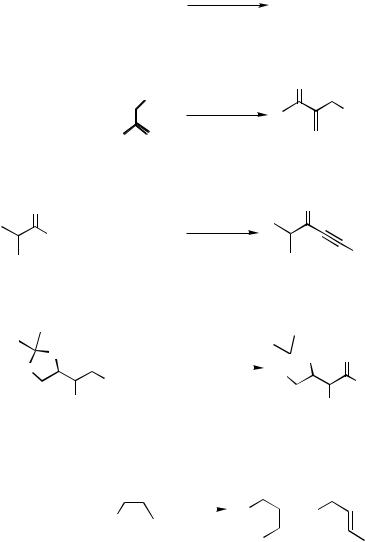
266 |
III Pd-CATALYZED CROSS-COUPLING |
By using trimethylor tributyltin as anchoring groups, the order of group transfer from tin is as follows:
RC#C RCH"CH aryl allyl, benzyl alkyl
This order appears to be general to other electrophiles. Though oxalyl chloride is not a good substrate, chloroformates and carbamoyl chlorides are good substrates (Schemes 11 and 12).[31],[32] Some imidoyl chlorides are known to react with stannanes.[33],[34] Typical examples are shown in Schemes 6–12.
PdCl2(PPh3)2
PPh3
PhCOCl + Bu3SnH
in PhH, r.t.
Scheme 6[12]
TMS BnPdCl(PPh3)2
MeCOCl +
in CHCl3
Me3Sn
Scheme 7[31]
O
PdCl2(PPh3)2
Cl + Bu3SnC  CCO2Me
CCO2Me
in (CH2Cl)2
|
|
|
|
|
Scheme 8[28] |
||
O |
|
O |
|
+ Me4Sn |
BnPdCl(PPh3)2 |
||
O |
|
|
|
|
|
|
|
|
|
|
Cl |
15 psi CO |
|||
|
|
|
|||||
|
|
|
|
|
|||
|
|
|
|
|
in HMPA |
||
|
|
|
|
|
|
||
OBoc
PhCHO
95%
O
TMS
81%
O
CO2Me
67%
 O O
O O
O
Me
OBoc
87%
Scheme 9[29]
|
|
|
|
Pd2(dba)3 |
|
O |
|
O |
|||
|
|
|
|
|
|
|
|||||
|
|
|
|
P(2-furyl)3 |
|
|
|
|
|
|
|
|
|
|
|
|
|
|
|
||||
PhCOCl + |
|
|
|
|
Ph |
|
|
|
+ Ph |
||
|
|
|
|
|
|
||||||
Bu3Sn |
|
|
in THF |
|
|
|
|
|
|
||
|
|
|
|
I |
II |
||||||
I + II |
= 97% I:II = 95.5: 4.5 |
||||||||||
|
|
|
|
Scheme 10[21] |
|
|
|
|
|
|
|
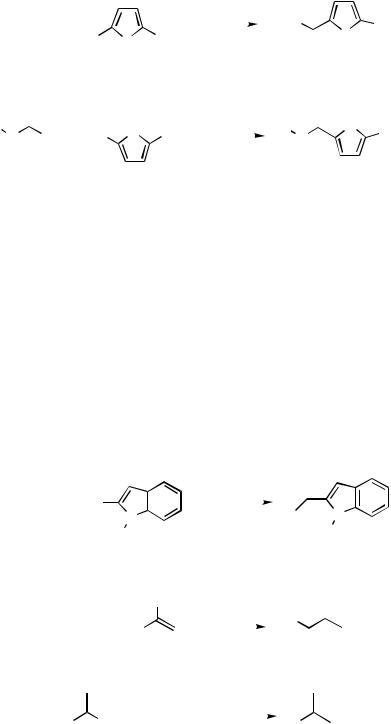
|
|
|
|
|
III.2.3 OVERVIEW OF THE STILLE PROTOCOL WITH Sn 267 |
||||||||||||||
|
|
|
|
|
|
|
|
PdCl2(PPh3)2 |
|
|
|
|
|
|
|
|
|||
i-BuOCOCl |
+ |
|
|
|
hydroquinone |
i-BuO |
|
|
CHO |
||||||||||
|
|
|
|
|
|
|
O |
||||||||||||
|
|
|
in PhMe |
||||||||||||||||
|
|
|
|
Bu3Sn |
O |
CHO |
|
|
|
|
|
|
|||||||
|
|
|
|
|
|
|
|
|
HMPA |
|
O |
70% |
|
||||||
|
|
|
|
|
|
|
Scheme 11[32] |
|
|
|
|
|
|
|
|
||||
|
O |
|
Me |
|
|
PdCl2(PPh3)2 |
|
|
|
O |
Me |
|
|||||||
|
|
|
|
|
|
|
|
|
|
|
|
|
|
|
|||||
|
|
|
|
|
|
|
|
hydroquinone |
|
|
|
|
|
|
|
||||
Ph |
|
|
|
|
|
|
Ph |
|
|
N |
|
||||||||
N Cl |
+ Bu3Sn |
N |
CHO |
|
|
|
|
N |
|
|
CHO |
||||||||
|
in PhMe |
|
|
||||||||||||||||
|
|
|
|
|
|
|
|
|
|
|
|
|
|
|
|
|
|||
Me |
|
|
|
|
|
HMPA |
Me |
|
|
|
|||||||||
65%
Scheme 12[32]
D. REACTIONS OF BENZYL HALIDES WITH ORGANOTINS
Relatively few reactions of this type have been performed. Benzyl bromide reacts with tetramethyltin, vinyltributyltin, and tetraphenyltin under catalysis by BnPdCl(PPh3)2 in HMPA to produce the corresponding methylated, vinylated, and phenylated products, respectively, in good yields. The reaction between Me4Sn and optically active benzylic bromide proceeds with inversion of configuration at the stereogenic center.[8],[9] Some exmples are shown in Schemes 13–17. An unfamiliar example is the reaction using nitrogen ligand on palladium (Scheme 16).[37]
Pd(PPh3)4
PhCH2Br + Bu3SnCH=CH2  PhCH2CH=CH2
PhCH2CH=CH2
in HMPA
100%
Scheme 13[9]
|
|
|
|
|
|
|
Pd2(dba)3 |
|
|
|
|
|
|
PhCH2Br + Bu3Sn |
|
|
|
|
|
2 P(2-furyl)3 |
|
|
|
|
|
||
|
|
|
|
|
|
|
|||||||
N |
|
|
|
|
in THF |
|
Ph |
|
|
N |
|||
|
|
|
|
|
|
|
|
|
|||||
|
|
|
|
|
|
|
|
|
|
|
SEM |
||
|
|
SEM |
|
|
|
|
|
|
|
|
|
||
|
|
|
|
|
|
|
|
|
|
95% |
|||
|
|
|
|
|
|
|
|
|
|
|
|||
|
|
|
|
Scheme 14[35] |
|
|
|
|
|
||||
|
|
|
|
OEt 1. PdCl2(PPh3)2 |
|
|
|
O |
|||||
|
|
|
|
|
|
|
|
||||||
PhCH2Cl + Bu3Sn |
|
|
|
|
in PhMe |
|
|
Ph |
|
|
|
||
|
|
|
|
|
|
|
|||||||
|
|
|
2. HCl |
|
|
72% |
|
||||||
|
|
|
|
|
|
|
|
|
|||||
|
|
|
|
Scheme 15[36] |
|
|
|
|
|
||||
|
|
|
|
|
Pd(2,2′-bipyridyl) |
|
|
|
|
|
|||
|
|
+ Me4Sn |
fumaronitrile |
|
|
|
|
|
|||||
Ph |
Br |
|
|
Ph |
77% |
|
|||||||
|
|
|
|||||||||||
|
|
|
|
|
in HMPA |
|
|
||||||
|
|
|
|
|
|
|
|
|
|
||||
|
|
|
|
|
|
|
|
|
|
|
|
||
Scheme 16[37]
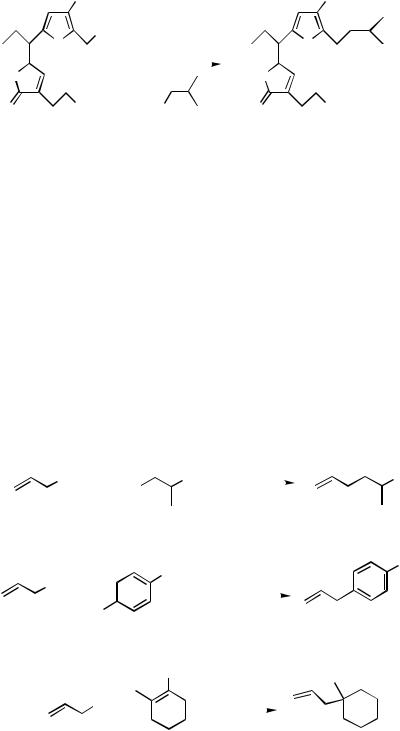
268 III |
Pd-CATALYZED CROSS-COUPLING |
|
|
|
|
|
|
|
|
||||||||
|
|
|
CO2Me |
|
|
|
|
|
|
|
CO2Me |
||||||
|
|
|
Br |
|
|
|
|
|
|
|
|
|
|
|
TMS |
||
|
|
|
|
|
|
|
|
|
|
||||||||
|
|
|
|
|
|
|
|
|
|
|
|
|
|
||||
|
|
|
|
|
|
|
|
|
|
|
|
|
|
|
|||
|
|
|
O |
|
|
|
|
|
|
|
O |
||||||
|
|
|
1) 40% aq. HF |
|
|
|
|
|
|
|
|
|
|
|
|
||
|
|
|
|
|
|
|
|
|
|
|
|
|
|
||||
O |
2) |
|
|
|
|
TMS |
O |
OH |
|||||||||
|
|
|
|
||||||||||||||
|
|
|
|
|
|
|
|
|
|||||||||
O |
OTBDPS Bu3Sn |
|
|
|
|
O |
|||||||||||
|
|
|
|
Pd(PPh3)4 |
in PhH |
|
|
|
51% |
|
|
|
|
||||
Scheme 17[38]
E. REACTIONS OF ALLYL HALIDES AND ACETATES
WITH ORGANOTINS
In 1980 Godschalx and Stille[39] and Trost and Keinan[40],[41] independently reported the coupling of allyl bromides and acetates with allyltin reagents, respectively. Since the reaction may proceed via -allylpalladium intermediate initially formed, the coupling at either the - or the -position seems to be possible. The reaction takes place in most cases at the less substituted terminus of the allylic moiety in the halide or acetate, but predominant allylic rearrangement is observed with that in the tin. More information is available from the literature.[25] In 1981 Beletskaya reported the formation of some amounts of homo-coupling product derived from the stannane along with the cross-coupling reaction of allyl acetates with arylor vinyltins.[42]–[45] The reaction with allyl bromide in HMPA readily occurs under ligandless palladium, but phosphine ligand on palladium was necessary for the reaction of less reactive acetates. The use of propargyl halide is rather rare. Their reaction with some stannanes gives allene derivatives predominantly.[46] Some examples are shown in Schemes 18–21.
Br |
|
|
|
OH |
PdCl2(MeCN)2 |
|
OH |
|
+ |
|
|
|
|
|
|||
|
Me3Sn |
in DMF |
|
|
||||
|
|
|
|
|||||
89%
Scheme 18[47]
OMe
|
|
|
OMe |
|
|
|
|||
Br |
+ |
|
|
[(η3-C3H5)PdCl]2 |
|
|
|
||
|
|
|
|
||||||
|
Me3Sn |
|
|
|
in DMF |
80% |
|
||
|
|
|
|
|
|
|
|||
|
|
|
Scheme 19[48] |
|
|
|
|||
|
|
|
OSnBu3 |
|
O |
||||
|
OAc |
+ |
|
Pd(PPh3)4 |
|
|
|
||
|
|
|
|
|
|||||
|
|
|
|
|
|
|
|||
|
|
in THF |
|
|
|
||||
|
|
|
|
|
|
|
|
||
90%
Scheme 20[40]

|
|
|
|
III.2.3 OVERVIEW OF THE STILLE PROTOCOL WITH Sn 269 |
||||||||||
|
|
H |
|
|
|
|
Pd2(dba)3 |
|
|
|
H |
|
|
|
Bn N |
|
S |
+ |
|
2 P(2-furyl)3 |
Bn |
|
|
N |
S |
||||
|
|
|
|
|
|
|
|
|
|
|
|
|
|
|
|
|
|
|
|
|
in THF |
|
|
|
|
|
|
||
O |
N |
Cl |
Bu3Sn O |
|
O |
N |
O |
|||||||
|
|
O |
|
|
|
|
|
|
|
O |
|
|||
|
|
|
|
|
|
|
|
|
|
|
CO2CHPh2 |
|||
|
|
|
|
CO2CHPh2 |
|
|
|
|
|
|
|
|
||
Scheme 21[49]
F. REACTIONS OF ARYL OR HETEROCYCLIC HALIDES AND TRIFLATES WITH ORGANOTINS
An initial report was on the reaction of aryl bromides with allyltins under Pd(PPh3)4 in benzene, indicating that aryl bromides are good substrates, but aryl iodides are poor.[4] A careful tuning of solvents and catalysts enabled the enrollment of both aryl bromides and iodides.[9],[13],[14] Use of chlorides is limited to those with electron-withdrawing substituents at the proper positions.
When ligandless palladium is generated from such palladium complexes as LiPdCl3 or PdCl2(MeCN)2 in solvents, such as HMPA, DMF, or acetone, the coupling reactions with aryl iodides take place at ambient temperature.[14]
Not only allyl, vinylic, and aryltins, but also alkyl and some hetero-substituted tins can be utilized in this protocol. Cyanomethylation, acetonylation, ethoxycarbonylmethylation, and N,N-diethylamination required tri(o-tolyl)phosphine as ligand on palla- dium.[50]–[53] Quite recently, aromatic amination was developed without the use of stannylamines.[54]–[56]
Aromatic diazonium salts instead of the aryl halides also undergo Pd-catalyzed coupling of organotins, but they are less used.[57] Aryl triflates are more popular.[58] The reaction of the triflate required LiCl as an additive. It was explained that triflate ligand of the oxidative adduct has to be replaced by chloride ligand before the transmetallation step. The system composed of AsPh3 as ligand and NMP as solvent seems so far to be the most efficient for cross-coupling with aryl triflates.[22] It does not require LiCl as an additive. The tolerance of heteroaryl halides and triflates is also noteworthy. Some examples are shown in Schemes 22–28.
Pd(PPh3)4
PhBr + Me4Sn  PhMe
PhMe
in HMPA, air
89%
Scheme 22[9]
Pd2(dba)3
P(2-furyl)3
PhI + Bu3SnCH=CH2  PhCH=CH2
PhCH=CH2
in THF
>95%
Scheme 23[23]
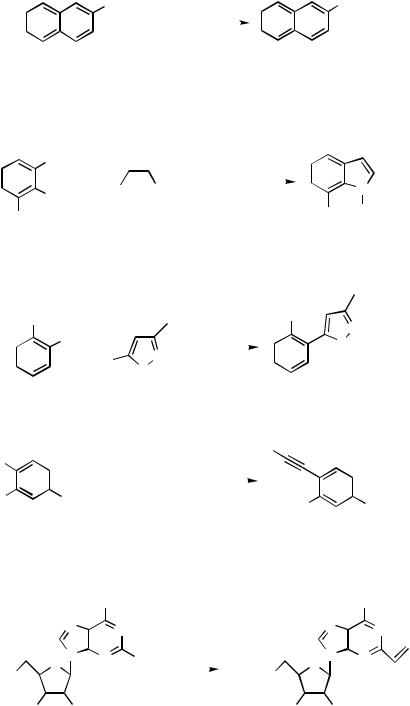
270 |
III Pd-CATALYZED CROSS-COUPLING |
|
|
|
|
|
|
|
|
|
|||||
|
|
|
OTf |
|
|
|
Pd(dba)2 |
|
|
|
R |
||||
|
|
|
|
+ RSnBu3 |
PPh3 |
|
|
|
|
|
|
|
|||
|
|
|
|
|
|
|
|
|
|||||||
|
|
|
|
LiCl |
|
|
|
|
|
|
|||||
|
|
|
|
|
|
|
|
|
|
|
|
|
|||
|
|
|
|
|
|
|
in THF |
|
|
|
|
||||
|
|
|
|
|
|
|
|
|
|
|
|
67−75% |
|||
|
|
|
R = H, CH=CH2, 2-thienyl, Ph, (E)-CH=CHPh, C |
|
CPh |
||||||||||
|
|
|
|
||||||||||||
|
|
|
|
||||||||||||
|
|
|
|
||||||||||||
|
|
|
|
|
|
Scheme 24[59] |
|
|
|
|
|||||
|
|
|
Br |
|
|
|
1. PdCl2(PPh3)2 |
|
|
|
|
||||
|
|
|
+ Bu3Sn |
|
|
OEt |
Et4NCl in MeCN |
N |
|||||||
|
|
|
|
|
|||||||||||
|
|
|
|
|
2. H |
+ |
|
|
|
|
|
|
|||
|
|
||||||||||||||
|
|
|
NH2 |
|
|
|
|
|
|
|
|
|
|
|
|
|
|
|
|
|
|
|
|
|
|
|
|
|
|
|
|
Br |
Br |
H |
|
||
|
|
|
|
96% |
|
|
Scheme 25[48] |
|
|
NO2 |
|
|
|
|
|
|
|
|
NO2 |
|
N |
|
|
|
Br |
|
|
|
PdCl2(PPh3)2 |
|
|
|
||||
|
|
|
|
|
|
|
O |
||||||
|
+ |
|
|
|
|
|
|
|
|
|
|||
|
|
|
N in dioxane |
|
|
|
|
||||||
|
|
Bu3Sn |
O |
|
|
|
|
||||||
|
|
|
|
|
|
|
|
|
|
|
|||
|
|
|
|
|
|
|
|
|
|
|
|
||
|
|
|
|
|
|
|
|
|
|
|
|
90% |
|
|
|
|
|
|
Scheme 26[60] |
|
|
|
|
||||
TfO |
|
|
|
|
|
|
Me3Si |
|
|
|
|
||
|
|
|
|
|
|
Pd(PPh3)4 |
|
|
|
|
|||
|
|
+ Bu3SnC |
|
CSiMe3 |
|
|
|
|
|||||
|
|
|
|
|
|
|
|||||||
|
|
|
|
|
|
|
|
|
|||||
AcHN |
|
CO2Me |
|
|
|
|
LiCl |
|
|
|
|
||
|
|
|
|
|
|
|
|
||||||
|
|
|
|
|
in dioxane |
AcHN |
|
CO2Me |
|||||
|
|
|
|
|
|
|
|
||||||
|
|
|
|
|
|
|
|
|
|
|
|
97% |
|
|
|
|
|
|
Scheme 27[61] |
|
|
|
|
||||
|
|
|
OMe |
|
|
|
|
|
OMe |
|
N |
|
N |
|
|
|
N |
|
N |
|
N |
|
I Bu3SnCH=CH2 |
N |
|
||||
|
|
N |
|
N |
|||||
|
|
|
|||||||
TBDMSO |
O |
|
|
|
|
TBDMSO |
O |
|
|
|
|
|
|
|
|
|
|
||
|
|
|
|
|
PdCl2(MeCN)2 |
|
|
|
|
|
|
|
|
|
in PhMe |
|
|
|
|
TBDMSO |
OTBDMS |
|
|
TBDMSO |
OTBDMS |
||||
|
|
|
|
|
|
|
>90% |
|
|
|
|
|
|
Scheme 28[62]–[64] |
|
|
|
||
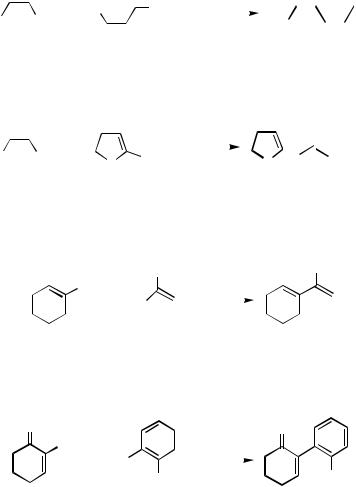
III.2.3 OVERVIEW OF THE STILLE PROTOCOL WITH Sn |
271 |
G. REACTIONS OF ALKENYL HALIDES AND TRIFLATES WITH ORGANOTINS
Although few examples of alkenyl chlorides are involved, the corresponding bromides and iodides are generally useful electrophiles. The cross-coupling of alkenyl iodides is often stereospecific, but that of the bromides sometimes involves E Z isomerizations due to the required elevated reaction temperatures. The tolerance of alkenyl triflates has quite enhanced the potential of this protocol as a useful synthetic tool owing to the ready availability of isomerically pure alkenyl triflates. Their reactions usually require the addition of excess LiCl, while it is not necessary when AsPh3 and NMP are used as a ligand and a solvent, respectively, as described in Sect. F.[22] Some reactions are shown in Schemes 29–33.
n-Bu |
|
I |
+ Bu3Sn |
|
OH |
PdCl2(MeCN)2 |
|
|
|
||||
|
|
in DMF, r.t. |
||||
|
|
|
|
|||
|
|
|
|
|
|
Scheme 29[65]
|
|
|
|
|
|
Pd(OAc)2 |
||
|
|
|
+ |
|
|
P(o-tol)3 |
|
|
I |
|
CO2Me |
SnBu |
3 |
NEt3 |
|||
|
O |
|||||||
|
|
|
|
in MeCN |
||||
|
|
|
|
|
|
|||
|
|
|
|
Scheme 30[66] |
||||
|
|
|
|
OEt |
|
|
|
|
|
|
|
OTf |
|
|
|
Pd(PPh3)4 |
|
|
|
|
|
|
|
|
||
|
|
|
+ Me3Sn |
|
|
|
||
|
|
|
|
|
LiCl |
|||
|
|
|
|
|
|
|
in THF |
|
Scheme 31[67]
O
OTf |
|
|
Pd2(dba)3 |
|
Bu3Sn |
||||
|
||||
+ |
|
|||
in NMP |
||||
|
OMe |
|||
|
Scheme 32[22],[68] |
|||

 OH n-Bu
OH n-Bu 
78%
O  CO2Me
CO2Me
64%
OEt
82%
O
OMe
77%
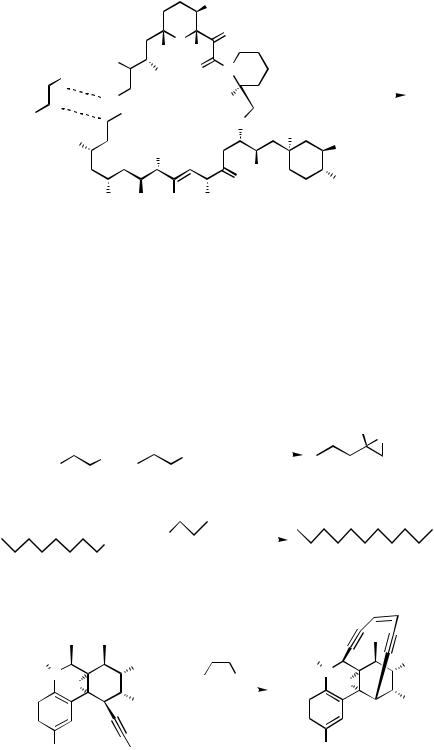
272 III |
Pd-CATALYZED CROSS-COUPLING |
|
|
|
|
|
|||||||
|
|
|
|
|
|
|
|
Me |
|
|
|
|
|
|
|
|
|
|
|
|
O |
O |
|
|
|
|
|
|
|
|
|
|
|
|
OH |
|
|
|
|
|
|
|
|
Me |
H |
|
|
|
|
|
|||||
|
|
|
O N |
|
|
|
PdCl2(MeCN)2 |
||||||
|
|
SnBu3 |
|
|
OMe |
|
|
|
|||||
|
|
|
|
|
|||||||||
|
|
|
|
|
|
|
|
|
|
|
|
i-Pr2NEt |
|
|
|
|
|
|
|
|
|
|
|
|
|||
|
|
|
I |
|
H |
|
|
|
|
28% |
|||
|
|
|
|
|
|
|
|||||||
Bu3Sn |
|
|
|
I |
|
|
|
O |
|
in DMF/THF |
|||
|
|
|
|
O |
|
(1:1) |
|
||||||
|
|
|
|
|
|
|
|||||||
|
|
Me |
|
|
|
|
|
|
|
H |
|||
|
|
|
|
|
|
|
|
|
|
||||
|
|
O |
OH |
|
|
|
|
OMe |
|||||
|
|
|
|
|
|
|
|||||||
|
|
|
|
|
|
|
|
|
|||||
|
|
|
|
|
|
|
|
O |
Me |
|
OH |
||
|
|
|
|
|
|
|
|
|
|||||
|
|
|
|
|
|
|
|
|
|
|
|||
|
|
Me |
OMe Me |
Me |
|
|
|
|
|
||||
|
|
|
|
|
|
|
Scheme 33[69] |
|
|
|
|
|
|
H. REACTIONS OF ALKYL AND ALKYNYL HALIDES
WITH ORGANOTINS
Alkyl halides are less investigated in this protocol. -Halo ethers, thioethers, and lactones can be used in this protocol.[70],[71] -Halocarbonyl compounds react abnormally with allyland acetonyltins to give oxiranes via the attack at the carbonyl followed by the cyclization (Scheme 34).[70]–[73] The reaction appears to be a variation of a simple Lewis- acid-catalyzed aldol-type condensation. On the other hand, if a catalyst without phosphine ligand is used, 1,4-diketone is formed (Scheme 35).[74]
The use of alkynyl halides is rare, but a remarkable result is reported (Scheme 36).[75]
|
|
O |
O |
|
|
|
|
|
|
|
|
|
|
|
O |
Ph |
|
O |
|||||||||||||||
|
|
SnBu3 |
|
|
BnPdCl(PPh3)2 |
|
|
|
|
|
|
||||||||||||||||||||||
|
|
|
|
|
|
|
|
Br |
+ |
|
|
|
|
|
|
|
|
80% |
|
|
|
|
|
||||||||||
|
|
|
|
|
|
|
|
|
|
|
|
|
|
|
|
|
|||||||||||||||||
|
|
|
|
|
|
|
|
|
|
|
|
in THF |
|
|
|
|
|
|
|||||||||||||||
|
|
|
|
|
|
|
|
|
|
|
|||||||||||||||||||||||
|
Ph |
|
|
|
|
|
|
|
|
|
|
|
|
|
|
||||||||||||||||||
|
|
|
|
|
|
|
|
|
|
|
|
Scheme 34[70]–[73] |
|
|
|
|
|
|
|||||||||||||||
|
|
|
|
|
|
O |
|
|
|
|
|
|
|
|
|
|
|
|
|
|
|
|
|
|
|
|
O |
||||||
|
|
|
|
|
|
|
|
|
|
|
|
|
PdCl2(PhCN)2 |
|
|
|
|
|
|
||||||||||||||
|
|
|
|
|
|
|
|
Br + Bu3Sn |
|
|
|
|
|
|
|
|
|
|
|||||||||||||||
|
|
|
|
|
|
|
|
|
|
|
|
|
|
|
|
|
|
||||||||||||||||
|
|
|
|
|
|
|
|
|
|
|
|
|
|
|
|
|
|
|
|
|
|
|
|
|
|
|
|
|
|
||||
|
|
|
|
|
|
|
|
|
|
|
|
in PhH |
|
|
|
|
|
|
|||||||||||||||
|
|
|
|
|
|
|
|
|
|
|
|
O |
66% |
|
|
|
|
|
|||||||||||||||
|
|
|
|
|
|
|
|
|
|
|
|
|
|
|
|
|
|
|
|
|
|
|
|
|
|
O |
|||||||
|
|
|
|
|
|
|
|
|
|
|
|
|
|
|
|
|
|
|
|
|
|
|
|
|
|
|
|
|
|
||||
|
|
|
|
|
|
|
|
|
|
|
|
Scheme 35[74] |
|
|
|
|
|
|
|||||||||||||||
|
|
I |
|
|
|
|
|
|
|
|
|
|
|
|
|
|
|
|
|
|
|
|
|
|
|
|
|
||||||
|
|
|
|
|
|
|
|
|
|
|
|
|
|
|
|
|
|
|
|
MeO2C |
|
|
|
|
|
|
|||||||
|
|
|
|
|
|
|
|
|
|
|
|
|
|
|
|
|
|
||||||||||||||||
MeO2C |
OAc |
|
|
|
|
|
|
|
|
|
|
|
OAc |
||||||||||||||||||||
|
|
|
|
|
|
|
|
|
|
|
N |
|
|
|
|||||||||||||||||||
|
N |
|
|
|
Me3Sn |
|
|
|
|
|
|
|
|
|
|
|
|
|
|||||||||||||||
|
|
O |
|
|
|
|
|
SnMe3 |
O |
|
|
|
|
|
|||||||||||||||||||
|
|
|
|
|
|
|
|
|
OAc |
|
|
Pd(PPh3)4 |
|
|
|
|
|
|
OAc |
||||||||||||||
|
|
|
|
|
|
|
|
|
|
|
|
|
|
|
|||||||||||||||||||
|
|
|
|
|
|
|
|
|
|
|
|
|
|
in DMF |
|
|
|
|
|
|
|
|
|||||||||||
|
|
|
|
|
|
|
|
|
|
|
|
|
|
|
|
|
|
|
|
|
|
|
|
|
|
|
|
|
80% |
|
|
||
|
OTBDMS |
I |
|
|
|
|
|
|
|
|
|
|
|
OTBDMS |
|
|
|
|
|
||||||||||||||
Scheme 36[75]
